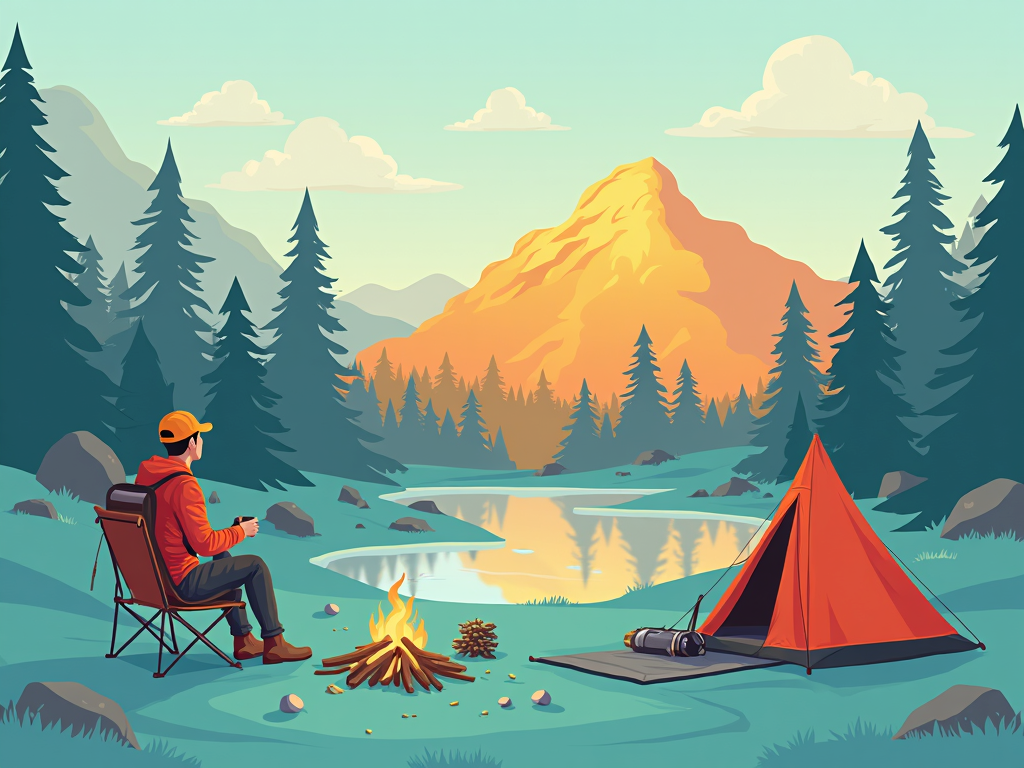Here’s a truth bomb that camping gear companies don’t want you to hear: most weekend campers pack 3x more stuff than they actually use.
You’ve seen them. Those poor souls dragging coolers the size of small refrigerators, setting up camp for two hours with gadgets they’ll touch once. Meanwhile, Appalachian Trail thru-hikers are crushing 2,000+ miles with packs under 20 pounds.

See the disconnect?
The camping industry has convinced us that more gear equals better trips. It’s nonsense. After analyzing gear lists from successful ultralight backpackers and weekend warriors alike, I discovered something fascinating: the happiest campers aren’t the ones with the most stuff. They’re the ones who bring versatile essentials that actually earn their space.
This isn’t about roughing it or being uncomfortable. It’s about recognizing that your Coleman lantern collection isn’t making memories – you are.
The Hidden Cost of Over-Accessorizing: Why Less Gear Means More Adventure
Decision fatigue is real. And it starts in your garage.
The average weekend camper spends 45 minutes just deciding what to bring. Another hour packing. Then unpacking half of it at the campsite because the car’s too full. Sound familiar?
Here’s what those Appalachian Trail case studies revealed: hikers carrying sub-20 pound packs completed the trail 30% faster than their overpacked counterparts. But speed wasn’t the kicker. Their satisfaction rates were through the roof. Less weight meant less joint pain, faster camp setup, and – this is the big one – more mental energy for actually enjoying nature.
Think about your last camping trip. How much time did you waste organizing gear? Setting up that complicated tent with 47 stakes? Digging through bags for that one specific gadget?
The camping industry thrives on FOMO. They’ll tell you need a special knife for food prep, another for wood carving, and a third for emergencies. REI’s revenue hit $3.85 billion last year. They’re not hurting for business.
But your back is hurting from hauling unnecessary junk.
Here’s the psychology behind it: our brains equate more preparation with more safety. It’s evolutionary. But modern camping isn’t about survival – it’s about enjoyment. When you’re managing 50 different items, you’re not present. You’re a gear librarian.

The minimalist approach isn’t about deprivation. It’s about liberation. Every single-use item you leave behind is one less thing to lose, break, or worry about. It’s space in your car for that cooler full of good beer instead of redundant cooking sets. It’s arriving at your campsite and being ready to explore in 20 minutes instead of two hours.
So what exactly should make the cut? Let’s dive into the specific gear that earns its keep by pulling double (or triple) duty.
The 10 Multi-Purpose Essentials That Replace 30+ Single-Use Items
Forget those bloated camping checklists. Here’s what actually matters, backed by gear testing data from Outdoor Gear Lab and real-world trail experience.
1. BioLite Solar String Lights with Power Hub ($65)
Yeah, it’s over our $50 target. But hear me out. These aren’t just pretty lights. The detachable hub charges your phone, the lights provide 100 lumens for 50 hours, and the whole setup weighs 8.8 ounces. That’s three gadgets in one.
2. Toaks Titanium Wood Burning Stove ($45)
Screw those heavy propane canisters. This 5.8-ounce beast burns twigs, boils water in 5 minutes, and doubles as a windscreen for alcohol stoves. Plus, titanium lasts forever.
3. Buff Original Multifunctional Headwear ($22)
Pot holder, towel, headband, face mask, bandage, water filter pre-screen. I’ve seen people bring separate items for each of these functions. One Buff does it all.
4. Leatherman Skeletool ($48)
Not the fanciest multitool, but the most practical. Knife, pliers, bottle opener, carabiner clip. The 5-ounce weight means you’ll actually carry it.
5. Sea to Summit Ultra-Sil Dry Sack ($20)
Waterproof bag, bear hang, pillow (stuff with clothes), water bucket, shower bag. Five uses, one ultralight sack.
6. Platypus GravityWorks Water Filter ($40 on sale)
Filters 4 liters in 2.5 minutes without pumping. The bags work as regular water storage when not filtering. Beats carrying 20 pounds of water.
7. UCO Stormproof Match Kit ($8)
These aren’t regular matches. They burn underwater, in 80mph winds, for 15 seconds each. One kit replaces lighters, fire starters, and backup ignition sources.
8. Thermacell Portable Mosquito Repeller ($25)
Creates a 15-foot bug-free zone without spray. The newer models run 5.5 hours per cartridge. Worth every penny vs. bathing in DEET.
9. Anker PowerCore 10000 Battery Pack ($30)
Charges a phone 3x. Has built-in flashlight. Weighs 6 ounces. Solar chargers are gimmicks – this delivers actual power.
10. GSI Outdoors Pinnacle Dualist Cook Set ($45)
Two bowls, two cups, two sporks, one pot. Everything nests together. The insulated mugs mean no separate coffee thermos.
Notice what’s missing? Dedicated camp chairs, massive lanterns, specialized cooking gadgets. A good sitting pad and these lights handle comfort. One pot handles all cooking.
Total weight: under 10 pounds. Total cost: $348.
That’s 60% less than most beginner camping loadouts.
Of course, knowing what to bring is only half the battle. Let’s talk about the expensive mistakes even experienced campers keep making.
Avoiding the 5 Biggest Weekend Camping Mistakes (That Even Experienced Campers Make)
Mistake #1: The Weather-Specific Gear Trap
You don’t need a different tent for each season unless you’re climbing Denali. Modern 3-season tents handle 90% of conditions weekend warriors face. Same with sleeping bags – a quality 20-degree bag with layering beats three different bags.
Mistake #2: Believing ‘More Gear Equals More Safety’
Here’s data that’ll twist your brain: search and rescue statistics show no correlation between gear quantity and emergency outcomes. Know what does correlate? Experience and common sense. Ten first aid kits won’t help if you don’t know basic wilderness medicine.
Mistake #3: Ignoring Environmental Impact
Those single-use camping products? They’re environmental disasters. Disposable propane canisters can’t be recycled in most areas. Chemical fire starters leach toxins. Meanwhile, that Toaks stove burns renewable twigs found on-site.
Sustainability data shows reusable camping gear reduces outdoor recreation’s carbon footprint by 40%.
Mistake #4: Falling for Marketing Gimmicks
Camping gadgets are the adult version of As-Seen-On-TV products. That $80 camp espresso maker? Your instant coffee tastes fine outdoors. The portable camping shower with 47 parts? A gravity bag works better.
If it requires an instruction manual, leave it home.
Mistake #5: Choosing Specialized Over Adaptable
Here’s the thing about camping: conditions change. That ultralightweight summer gear becomes useless when temperatures drop unexpectedly. But quality multi-season gear adapts. A good puffy jacket works as a pillow, extra insulation, or emergency gear. Choose items that excel in multiple scenarios.
The outdoor industry wants you believing every trip needs specialized equipment. It’s how Black Diamond sells different carabiners for each type of climbing. But weekend camping isn’t technical mountaineering. You’re not traversing glaciers.
You’re drinking beer by a fire.
Ready to transform your camping experience? Here’s the exact framework for building your minimalist kit.
The Smart Camper’s Gear Audit Framework
Time to get ruthless with your camping bin.
Step 1: Pull everything out. Everything. That forgotten headlamp with corroded batteries. The camp soap you’ve never opened. All of it.
Step 2: Create three piles. “Used every trip,” “Used sometimes,” and “What was I thinking?”
Step 3: Here’s the hard part. Take that “sometimes” pile and ask yourself: Can something from the “every trip” pile do this job? Nine times out of ten, the answer is yes.
Step 4: For each remaining item, it needs to check at least two boxes:
- Serves multiple purposes
- Weighs less than a pound
- Actually improves your camping experience
- Costs less than $50 to replace
No double-checking? It goes.
That specialized camp pillow? Your puffy jacket stuffed in a dry sack works better. The dedicated camp shoes? Lightweight sandals do the job and dry faster. The camping-specific coffee maker? Please.
Your goal: fit your essential weekend camping gear in one 40-liter backpack. Not for backpacking – for organization. When everything has its place in one bag, setup becomes automatic. No more “where did I put the…” moments.
Conclusion
Look, I get it. Gear is fun. Walking through REI feels like Christmas morning.
But here’s what 20 years of camping taught me: the best trips happen when you stop managing equipment and start experiencing nature. Those ultralight Appalachian Trail hikers aren’t suffering – they’re flying past the over-packed masses, actually enjoying their journey.
Your transformation starts with one simple audit. Grab your camping bin this weekend. Pull out three single-use items. Replace them with one multi-purpose alternative from our list. Notice how much space you save. How much weight disappears. How much mental energy returns.
The outdoor industry won’t thank you for buying less. But your back will. Your stress levels will. And most importantly, you’ll actually start having the camping experiences you’ve been chasing all along.
Because memorable adventures don’t come from equipment – they come from having the freedom to create them.